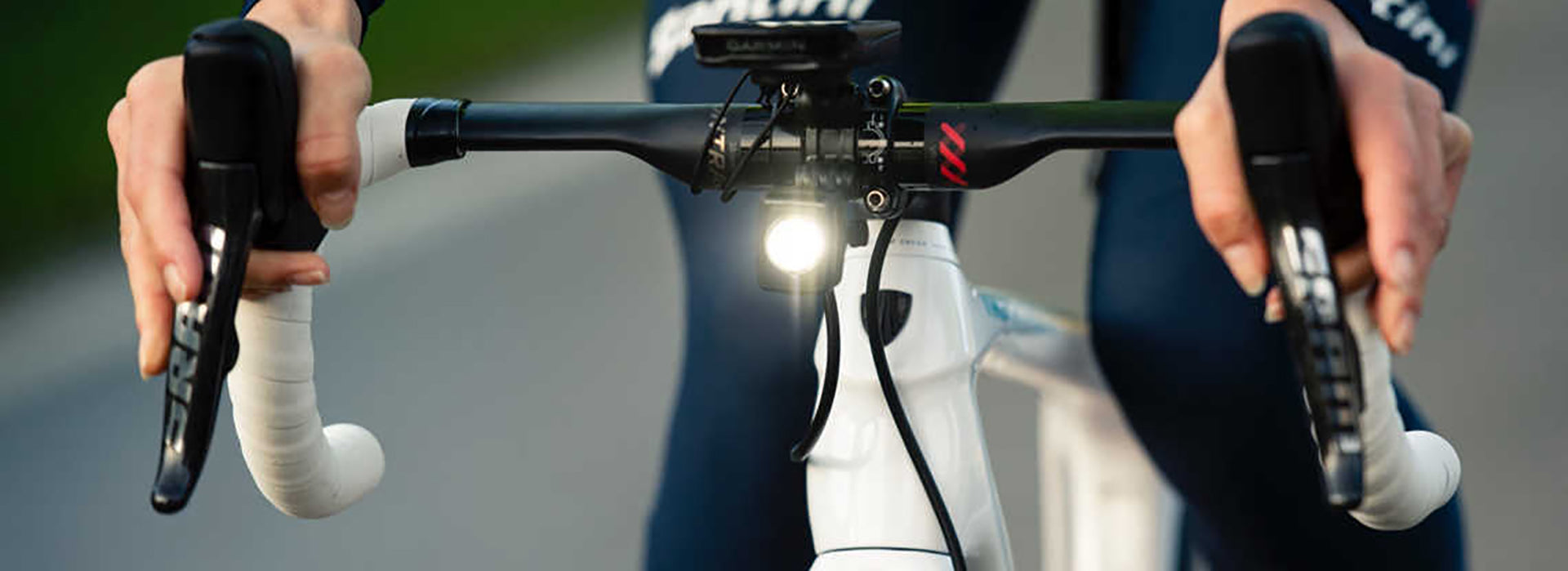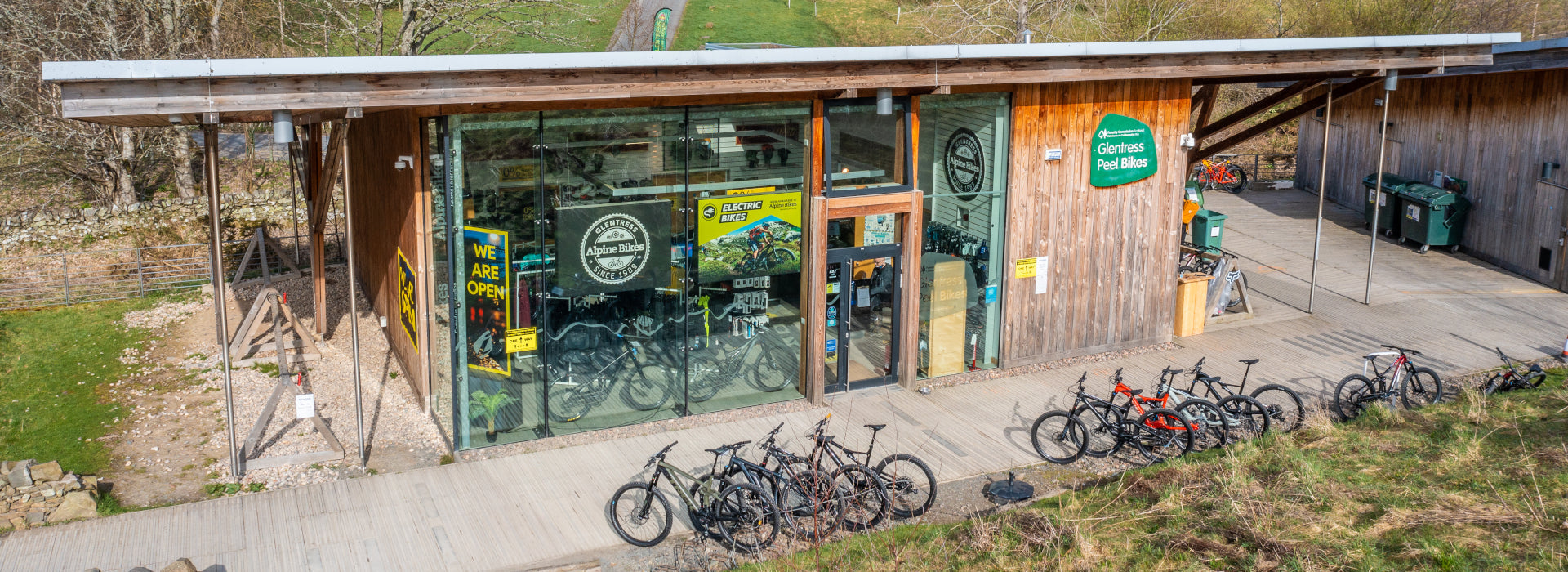
Bike Light Buying Guide
If you want to ride throughout the darker months, a great set of bicycle lights should not be underestimated but the exact ones you buy depend on where and how you are riding. There are plenty of options available, from small emergency body lights to high power 1000 lumens+ used to light up dark trails. What you need depends on what you want to do.
To See / To Be Seen
In general, all bike lights can be split into two categories. If you’re commuting through town, you need to ‘be seen’ by other road users while the streetlights will light up the road for you. However, if you’re off-road or on roads without streetlights in suburban or rural areas, then you really need a much higher power light for you ‘to see’ the dangers and corners coming your way. So, ‘to see’ or ‘to be seen’ – but how do you know which lights fit these categories? This is where power ratings come in. Most manufacturers give this in ‘lumens’ but there are a few other terms out there.
Lumens: this is a measurement of the amount of light emitted from a unit, but it doesn’t take into account the size of area illuminated. Broadly speaking, the more lumens, the more energy is emitted and the brighter the light.
Lux: this is a light’s brightness over a given area and works out as 1 lux = 1 lumen over 1 square metre. So, say you’re pointing your 100 lumen bike light at a wall producing a lit area 1m wide. That light would have 100 lux. Next to you at the same distance away from the wall, your friend has a 100 lumen bike light which is producing a lit area 1/10th smaller. That smaller area is ten times brighter, even with the same light output, and the light would have 1000 lux. So, you could say lux is how well an object is illuminated at a set distance from the light source. When bike lights are described as being x lux, it’s meant at 10metres away from the source.
Candela: one candela is essentially the light intensity of one ordinary candle and this is a measure of light intensity measured at the light source.
Watts: Watts is a more common measurement when we’re talking about lighting in other settings, i.e. at home. This is a measurement of how much electrical power the unit consumes so you can see why it is less relevant when it comes to bike lights as it doesn’t measure visible light. However, watts may be relevant when you move onto dynamo lights – but more on that later.

How Many Lumens?
So, now you know what the word ‘lumen’ means, but how many lumens do you need?
<100 lumens: most rear bike lights will be up to 100 lumens, so the closer you can get to 100, the better this light would be for your main rear light. As for your front light, anything up to 100 lumens is good as a back up light if your main one fails. You’ll be noticeable on a well-lit street but it won’t be any help for you to light up the road ahead of you. These lights are typically small and fit onto your body, helmet or bag and often termed ‘safety lights’. Having a couple of these smaller lights on different flashing or steady modes is a good option for urban environments.
100 - 500 lumens: anything over 200 lumens will cast a beam onto the road but at the lower end of this spectrum, it might still be difficult to see dangers such as potholes if there aren’t many street lights. These lights are a great, affordable option for your main front light in urban environments, perhaps with a smaller lumen one of your body.
500 - 800 lumens: once you step over the 500 lumens boundary, these lights perform well on semi-lit suburban streets where you need to be able to see the road but there are occasional streetlights. This level of output will show you all the dangers of potholes and debris you’ll need to avoid and travel at a decent speed.
1000+ lumens: if you’re riding on rural roads at night, then you’ll need a light above 1000 lumens so you can ride with confidence. The on-road bike lights will have a powerful beam showing you a long way in front of you. If you’re riding off-road at night, you’ll need to be as far above 1000 lumens as possible.
It’s worth noting that when a light advertises itself as having high lumen capability, you’ll get a shorter run time as it will drain the battery very quickly. However, they will also have the capability to lower their lumen output and flashing/steady modes to extend their battery life or adapt to your commuting environment.
Here's a comparison of four front and four rear lights of different lumens.

Beam Shapes
The shape of the beam becomes important at the higher end of the lumen spectrum. Round beams tend to be the choice for bike light manufacturers and are good for off road riding so you can see everything from low hanging branches to roots and loose gravel. However, if you’re planning on doing night road riding, a horizontal squared off beam should be a priority as they’re less dazzling for oncoming traffic and you aren’t wasting light where you don’t need it. These beam shapes are also important if you happen to be going for a ride in Germany, as they’re the only legal light type there. However, these beam shapes are less common in the UK, but if you do find them (or buy them abroad), they’re well worth it.

Day Lights and Side Visibility
Being noticeable by other road users is one step towards staying safe on the road or shared paths. It’s easy to think that during the day, lights aren’t necessary, but if you’ve got the light already, there’s no harm in switching it on. A flashing light will always catch someone’s eye, so even at the lower lumen end, they could really help your visibility especially considering how grey and flat the weather in the UK can be.
Some brands are developing specific ‘day lights’ or daytime running modes which boost intensity or flashing mode to make the light more effective. But if you don’t have the money to invest in multiple lights for different uses, it’s better to consider how much side visibility the light provides since 75% of accidents occur at junctions when you’ll be side on to traffic.
Here is a comparison between three rear lights showing an increase in lumens and increased side visibility:

Rear Bike Light Technology
Rear lights haven’t undergone the same lumen increase as front lights have, instead technology has developed to incorporate other features. Some lights now have movement sensors to adjust brightness when you’re braking which can be useful in urban areas where drivers are used to rear brake lights. You can also buy lights which have a camera built in or even display your speed in LEDs. Whichever light you choose, just being seen in the most important thing.

Batteries
There are three ways of powering your bike lights all of this come with their own pros and cons.
Removable batteries: lights with removable batteries will be cheap and last a long time, but their output won’t be bright. These lights should be in your bag as a back up if your main ones fail so you can still get home and be seen by other road users. If you rely on these as your main light source, the cost of replacement batteries will quickly exceed the cost of a USB chargeable light, so they can be a false economy unless you invest in rechargeable, removable batteries but in that case, why not just buy a USB rechargeable light?
USB rechargeable: while these lights are initially a little more expensive, they throw out a brighter beam and last long enough for one long ride to work where you can charge in time for your return home. These lights will just turn off once they’re out of juice, so some units will have a fuel gauge display to let you know their charge level so you’re not suddenly left in the dark.
Dynamo powered lights: modern LED dynamo lights are more reliable than their predecessors and can give a steady beam without much drag on your wheel. Of course, you need a dynamo hub in the first place and the light will turn off once you’ve stopped moving (or a short while after), but if you’re looking for a long lasting, forget-about-it light that’ll always be on when you’re moving, then they’re well worth considering the expense.

What Does the Law Say?
Since 1989, it has been illegal to ride on UK roads after dark without lights and reflectors. The light must be white light on the front and a red light on the rear, fitted to your bike and not your helmet and cannot be higher than 150cm from the ground.
Now, it’s unlikely that you’re going to get pulled over for a missing reflector if you have a great set of bike lights, but if you do lack these things and are involved in a night time crash then it could be considered negligence.
The minimum light output for flashing lights is four candela, which is equivalent to about 12 lumens. As for a maximum output… well there isn’t one. But dazzling oncoming traffic isn’t ideal so consider your light angle or beam shape as well as dimming it appropriately on road.
For flashing speed, a light must only between 60 and 240 times a minute, but the research is mixed for whether it is best to run steady or flashing lights in urban areas. So, if you have the cash you can’t go wrong with two lights on the front and two on the rear, each doing a steady or flashing mode.
Which Light Should You Get?
That's a wealth of information, but how does all that relate to the products we stock at Alpine?
Follow our flow chart to find out which products are best for you:

Collection A: Urban Riding
 |
 |
|
Bontrager Ion 100 R & Flare R Front and Rear Bike Light Set: this powerful but affordable combo gives you enough lumens to be seen well in urban environments but lasts up to an hour and a half of riding with your front light at full - the perfect amount for a bike commute. Charge it at work for your return home and you've got the perfect set up for quick winter urban commuting. |
Cateye Wearable Mini Rear Light: this handy little rear light serves as the perfect emergency light for added visibility in a busy environment. Set it to flash and clip it onto your bag or coat and you're ready to ride. The CR2032 battery will lasts hours upon hours so if you forget your other rear light, chances are this one will still have juice to get you home. |
Collection B: Suburban Commuting
 |
 |
|
Moon Meteor-X Pro & Arcturus-Pro Front and Rear Set: a solid, strong beam from the Meteor-X Pro will get you along darker suburban roads with a 2 hour run time and great visibility without the chance of dazzling other road users around you. Waterproof to ipx 4 means it won't get damaged during the rainy winter commute. |
Cateye AMPP 500 / VIZ 150 Front and Rear Set: providing a broad beam that lights the road ahead and high levels of visibility to all road users behind, this set is the perfect solution for riding during the darkest of nights. With a run time of 1.5 hours on the highest steady mode, it should be enough even for the longest commutes. |
Collection C: Rural Night Road Riding
 |
 |
|
Ion Comp R/Flare R City Light Set: tipping up to 700 lumens will light the road up ahead of you so you can ride with at night with confidence and avoid pot holes and other hazards. The Comp's beam will light up the whole width of the road and run for 1.5 hours on full power but that runtime can be extended when set to lower lumens. |
Cateye Orb Rear Light: a flashing secondary rear light attached to your bike or body may assist other road users in seeing you from behind and the 2032 batteries will keep the light going for hours upon hours. There is a rechargeable version if you'd rather be sure of being with power for your commute home and you'll also get a couple more lumens in there too. |
Collection D: Off Road Riding
 |
|
|
Bontrager Ion Pro RT & Flare RT2 Light Set: a strong light on your helmet will give you extra illumination wherever you turn you head. At 1300 lumens, you'll still have the visibility you need but it can be lowered if you find it too powerful and that can increase the unit's run time from 1.5 hours at at 1000 lumens to 6 hours at 400 lumens. The Flare-RT2 rear light features an integrated sensor to auto-adjust brightness to your environment. |
|







